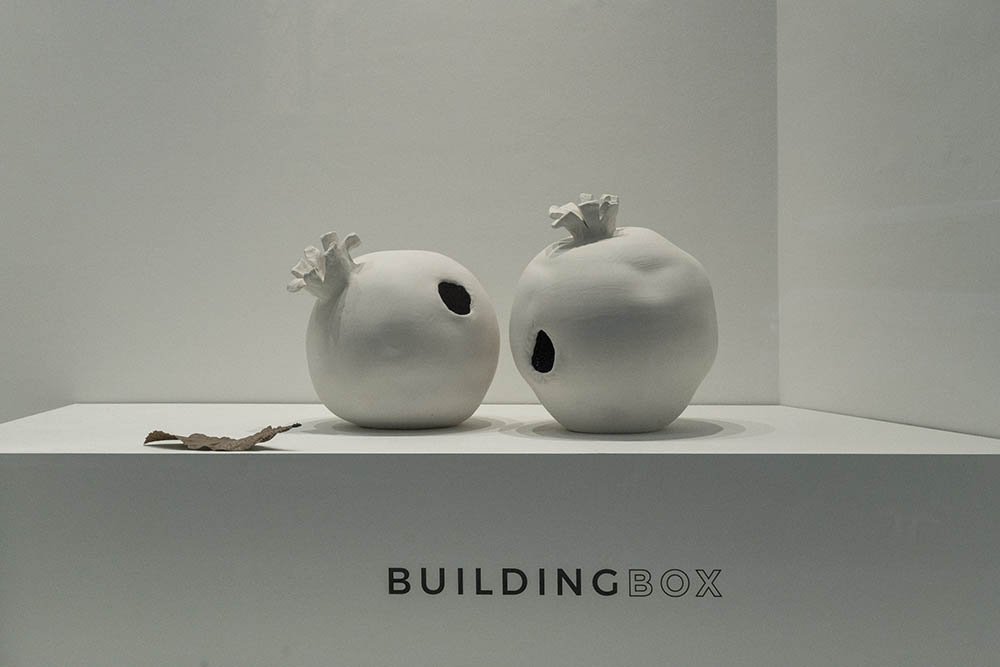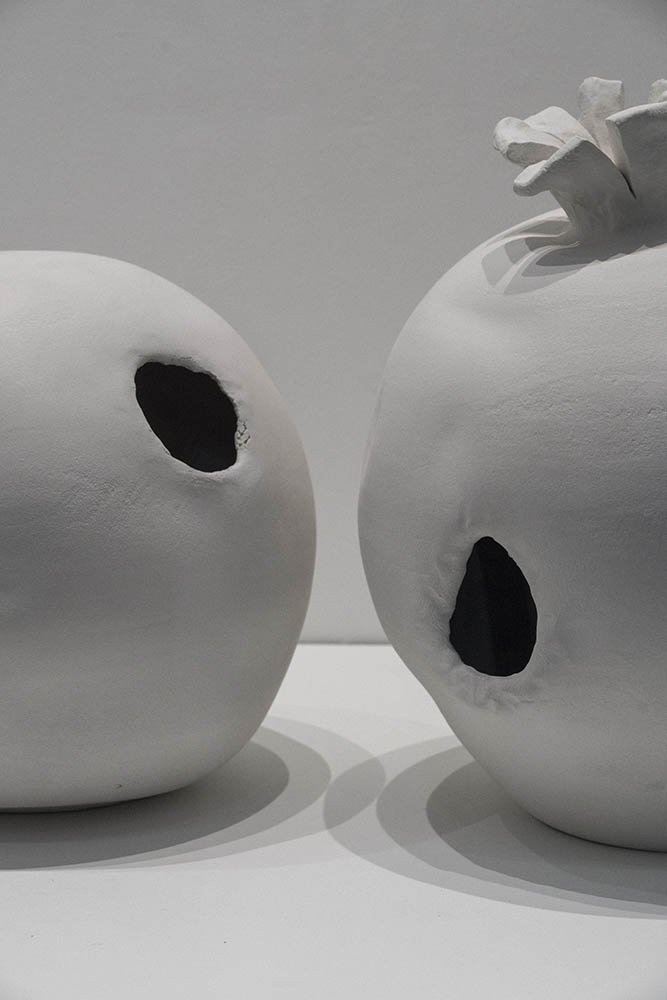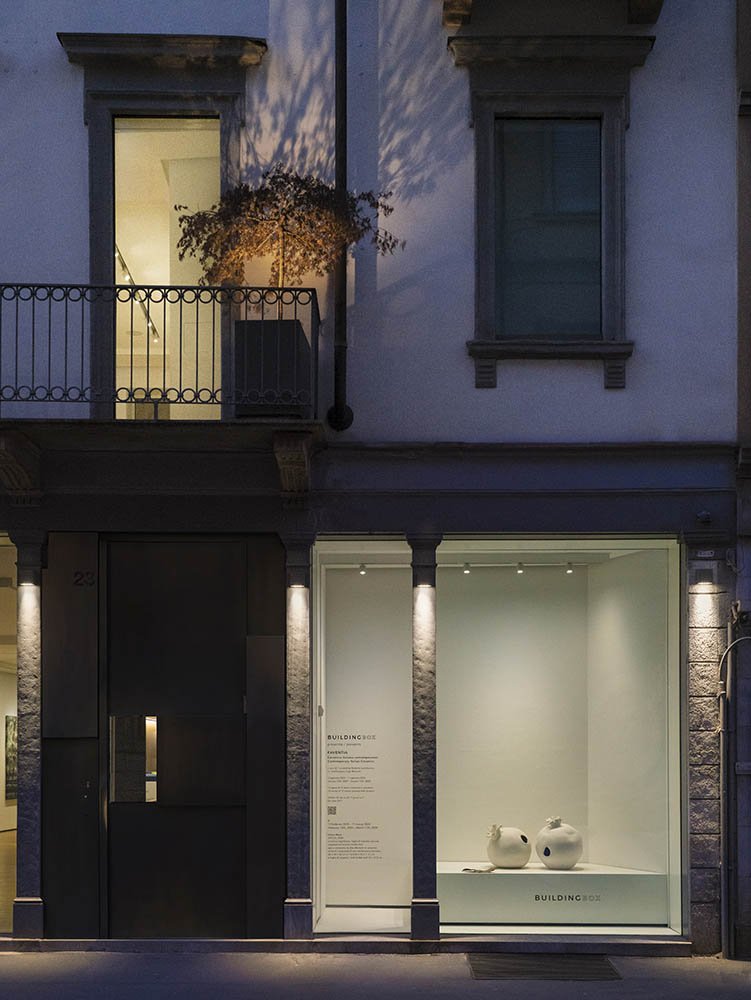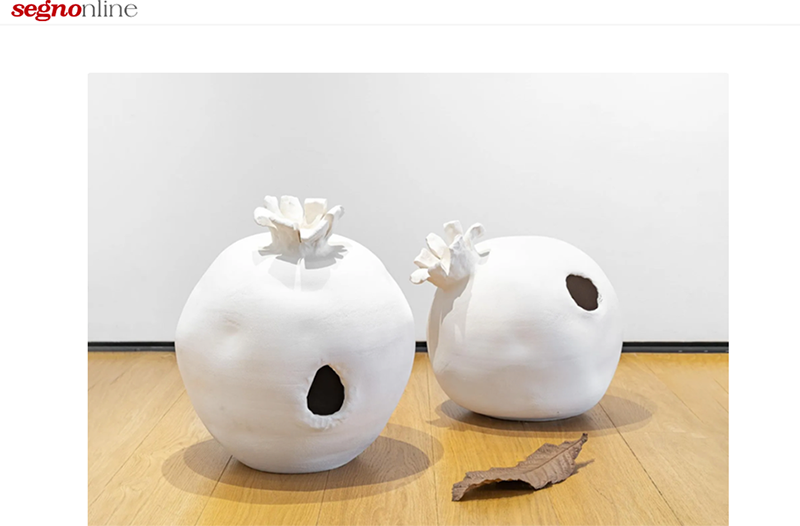FAVENTIA – 2/12. Liliana Moro
13.02.2024 – 11.03.2024
From February 13th to March 11th 2024, BUILDINGBOX hosts the artwork Still Life (2020) by the artist Liliana Moro (Milan, 1961).
The second artwork hosted in FAVENTIA. Ceramica italiana contemporanea [Contemporary Italian Ceramics] made with engobed earthenware and a medlar leaf, is Still Life (2020). The artist engages with the “still life” genre, a centuries-old genre, re-actualizing subjects, techniques, and spirit of research. The composition features two white pomegranates. Over the millennia, the pomegranate has acquired many symbologies, allegories, and metaphors. In the Exodus (28:33), for the mantle of the ephod – the Jewish holy vestment – it reads: “At the lower hem of the mantle, you shall sew pomegranates”: according to some Jewish traditions, the fruit came to symbolize “honesty”, considering the link between the, hypothetical, number of 613 seeds, or arils, contained in the fruit, and the 613 precepts of the Torah. The pomogranate is also an attribute of the Great Mother; in some monotheistic religions it is seen as a heavenly fruit, in the Song of Songs as “loving”, and in classical antiquity referred to the cyclical nature of life and death. It was also depicted by famous Renaissance artists in works with Marian subject (for instance by Vittore Carpaccio, Antonello da Messina, and Sandro Botticelli), evoking, time after time over the centuries, fertility, abundance, love, passion, martyrdom, and the unity of people. Beyond these few and rhapsodic examples, Liliana Moro, one might paradoxically say, empties out the fruit, leaving only its tough epicarp: thus, the “still life” is truly “still”, since inert, after being the victim of a violent action, holes appear, which can be conceptually traced back to the stroke of a pickaxe, or a peck that reveals the inscrutable internal darkness of the object in contrast to its external whiteness. An element destined to change over time, namely a real medlar leaf, sacred to Chronos, and whose fruit is a symbol of wisdom and patience, adds meaning to the work.
From the metaphysical kind of still life painted by Filippo De Pisis to Lucio Fontana’s “natures” of cosmic afflatus, Liliana Moro’s artwork, characterized with the artist’s usual essential nature and polysemy, builds bridges between past and future by reflecting on closely contemporary themes.
The work was made with the help of Davide Servadei – Bottega d’Arte Ceramica Gatti in Faenza.
From January 12th, 2024, to January 11th, 2025, BUILDINGBOX presents FAVENTIA. Ceramica italiana contemporanea [Contemporary Italian Ceramics], an exhibition project curated by Roberto Lacarbonara and Gaspare Luigi Marcone, involving twelve Italian artists invited to exhibit sculptures and installations made of ceramics. This programme is dedicated to the centuries-old artistic tradition of the city of Faenza, one of Italy’s main production districts, as well as the seat and epicentre of themed projects and museums such as the “MIC International Ceramics Museum”, the “Premio Faenza”, and the “Museo Carlo Zauli”. Furthermore, the exhibition was conceived as a tribute toward an area affected by the flood of May 2023.
As with BUILDINGBOX’s usual annual schedule, the exhibition hosts monthly interventions. In this edition, the artworks will be presented on the 12th day of each month. This “numerology” alludes to the cyclical nature and synthesis of earthly, spiritual, and temporal elements, as well as the numerous symbologies associated with the number 12 in history and cultures from different parts of the world.
The project maps and summarises some of the main artistic expressions related to the 20th and 21st centuries ceramics, promoting a series of artists from different generations who, consistently or sporadically with respect to their own production, use clay working techniques by continuing, recovering, or revolutionising the extraordinary manual skill of moulding, and the chromatic-luminist value of the glazes.
The ancient Faventia has been a land of artisan production since Roman times, a characteristic that was enhanced in later centuries. Indeed, it became synonymous of the majolica ceramics in many languages – French (faïance), English (faience). In recent years, many artists have used the Faenza kilns – also thanks to residency programmes, exhibitions, workshops, prizes, and publications – for the artistic production of medium and large-scale sculptures, often designed for an environmental development and installation purposes. The primal, demiurgic act of shaping the clay gives ceramics an exclusive status, almost an ontology, the auroral condition of sculpture. In the manipulation’s plastic immediacy that precedes the firing that crystallises the piece, there is all the naturalness of a slow, thoughtful transformation poised between design and chance. In ceramics, as in drawing, there is the seed of an origin, that appears on the surface of the image and things in the precise moment of their conception. Ceramics – beyond the categorisations between craft, art, functional objects, unique, or mass-produced piece – possesses an intermediary (or intermediality) between thought and gesture, sign and sculpture, form and colour, operating, moreover, with various natural elements such as earth, water, and fire; and by hybridising artistic languages, techniques, research, and knowledge between artists and artisans.









